- Home
- About Me
- Projects
- Documentaries
- National Geographic: Earth Live 2017
- BBC: Planet Earth II – Cities 2016
- BBC: Planet Earth II – Grasslands 2015
- Animal Planet: Mysterious Wilds of India 2015
- BBC: India – Nature`s Wonderland 2015
- BBC: Wonders of the Monsoon 2014
- National Geographic: Urban Jungle– Downtown 2013
- Animal Planet: Return of the Clouded Leopards 2011
- National Geographic: Secrets of Wild India 2011
- National Geographic: The Secrets of the King Cobra 2009
- BBC: Natural World- Mountains of the Monsoon 2008
- Discovery Channel: Sahyadris – Mountains Of The Monsoon 2002
- Short Documentaries
- Books
- Documentaries
- AWARDS
- NEWS
- Blog
- Contact Me
- Store
Blog
In India as in many parts of South Asia, this is the time of the New Year. This is the time when the northward transition of the Sun from Dhanu rashi (Sagittarius) to Makara rashi (Capricorn) takes place. Known as Makara Sankranti – the harvest festival – it is a time that marks the ending of winter and the beginning of spring. A very auspicious time in the Hindu calendar as it is the beginning of a New Year. With this, I’d like to take the opportunity to launch my new website and blog wherein one can find answers to many questions and get a peep into the behind the scenes of Wildlife filmmaking and photography. The website is still under-construction so check back frequently for more updates and features. The first photo-essay on the blog page is about my work with clouded leopards for an upcoming documentary.
———————————————————————————————————————————————————————————
In 2009 a dream project shifted my base camp to North-Eastern India. My job was simple albeit a bit broad – document the natural and cultural treasures of the Eastern Himalaya. One of my target species of course, was the clouded leopard. I knew my chances of seeing one was practically non-existent, but just knowing that somewhere in the jungles around me this cat prowls was enough to keep me excited and look for signs of its possible presence. I traveled all along the foothill forests of the Himalaya and although local people knew of the clouded leopard, finding one was nearly impossible.
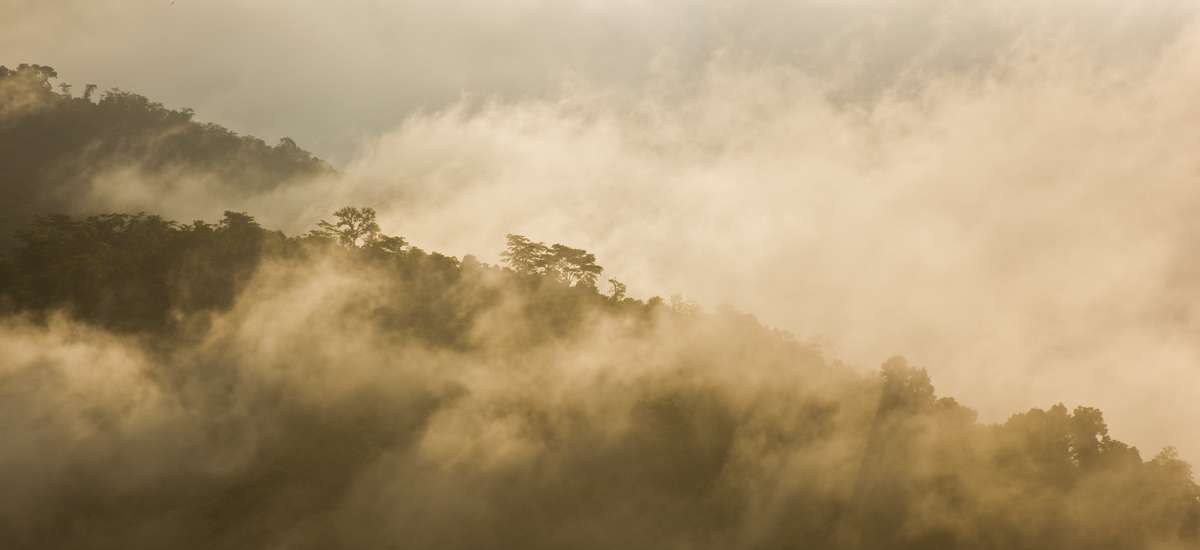
Found through much of the forested regions of Southeast Asia, clouded leopards range from sea level up to about 2000 meters plus in the Himalaya.
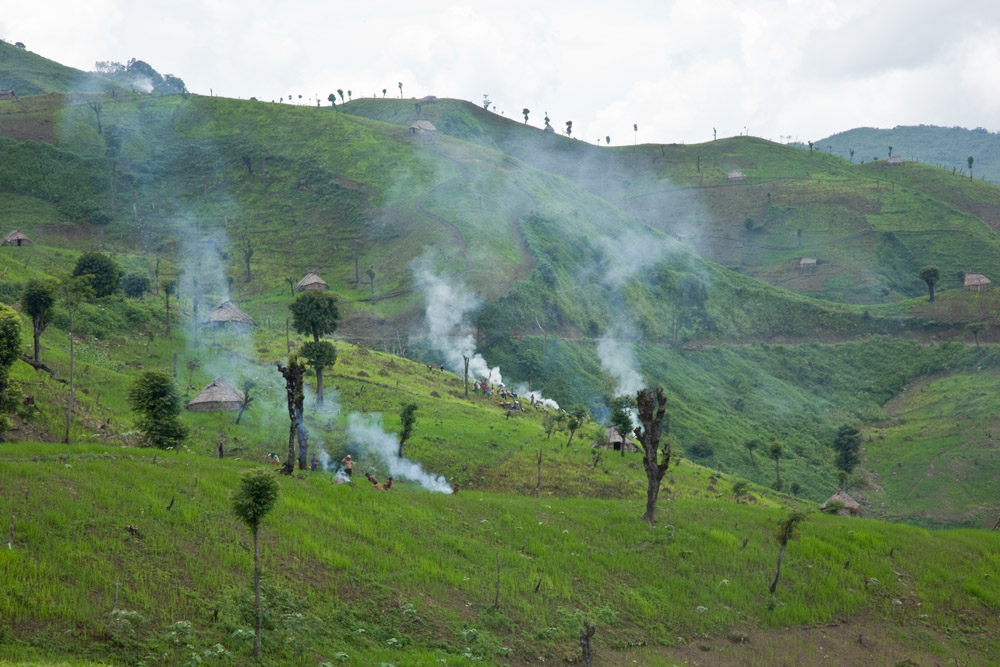
With increased pressure on land clouded leopards numbers are declining. They are listed as Vulnerable in the IUCN Redlist with an estimated population of less than ten thousand individuals – a guesstimate at best.
The few animals that persist in human dominated landscape don’t survive for long. In most parts of Arunachal Pradesh and Nagaland men carry rifles as part of their everyday attire. They shoot whatever they come across that is sizeable enough to be eaten including clouded leopards.

My first sign of the presence of these cats came at a market place in Arunachal Pradesh. Here a clouded leopard skull adorns the sword, or Dhaow worn by the local headman’s son.

A few weeks later I stopped at a government run handicraft shop (not disclosing location). I was shocked to find a colourful stone, studded clouded leopard lower jaw adorning a Dhaow being sold for 3000 Rupees – about 60 US dollars.
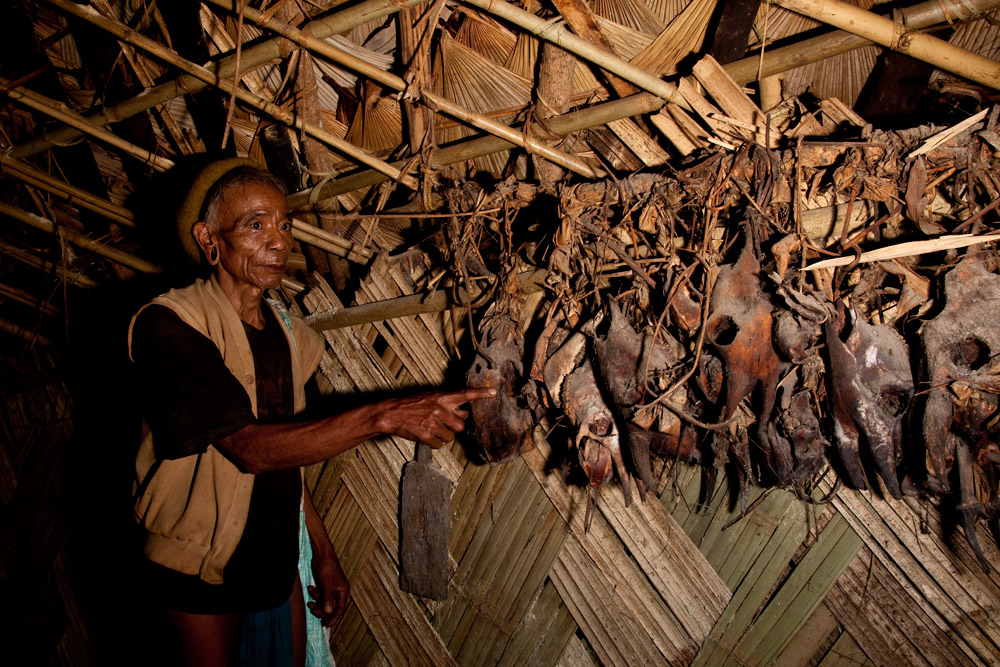
Skins and skulls of various rarely seen species are part of common decor in the kitchens’ of many Naga tribes – the best place to do a faunal biodiversity inventory. In fact a new species of leaf deer unknown to India, or to science was found rummaging through these dusty collections of old skulls and bones.

A full-grown clouded leopard coat hangs inside a Naga kitchen. It was shot during the obligatory ‘no-hunting season’ by the village headman of Zipu village near Shatuza on the Indo-Myanmar border.
All in all, this was the closest I got to seeing a clouded leopard – a smelly skin of a clouded leopard shot just because it happened to be walking on the trail while the headman was on his way to work on his field.
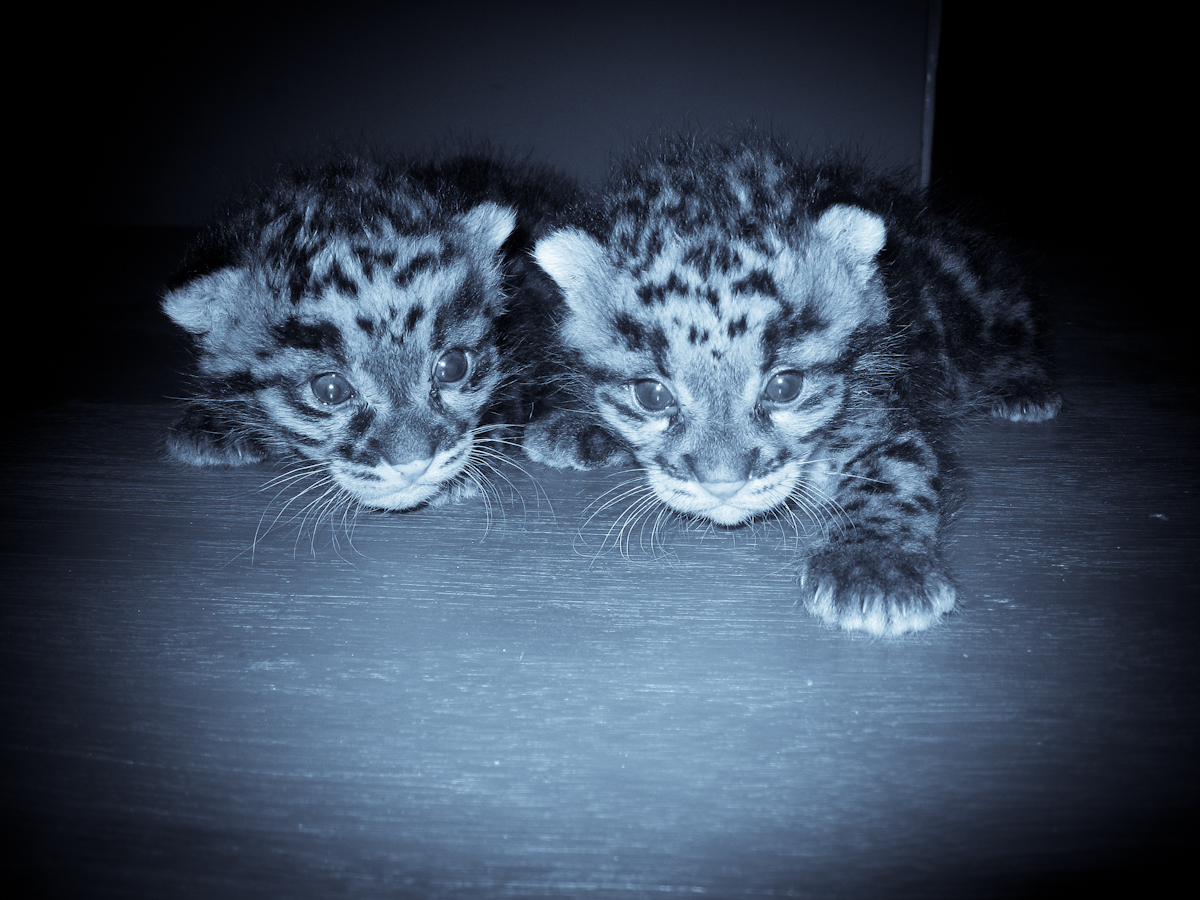
Running parallel to the sad story of the plight of clouded leopards in the wild was the more uplifting story of Runaa and Khota, two clouded leopard kittens found along the Indo-bhutan border west of Manas Tiger reserve. Photo credit: Panjit Basumatary/ WTI
Panjit the vet at Wildlife Trust of India’s center for wildlife rescue in Kokrajhar was assigned the duty of looking after these cubs hardly a few days old. The cubs were confiscated by Sonali Ghosh who was the DFO in charge of the area and wanted to figure out a way to get the cubs back into the wild.


I heard about this six to seven months later and thought that it would make a wonderful story as it was the closest I was getting to seeing a clouded leopard in the wild. So I rushed to the area and began documenting the process of rehabilitation. Initially the cubs were led on a long leash to get them used to their new home – the forested foothills of the Bhutan Himalaya.
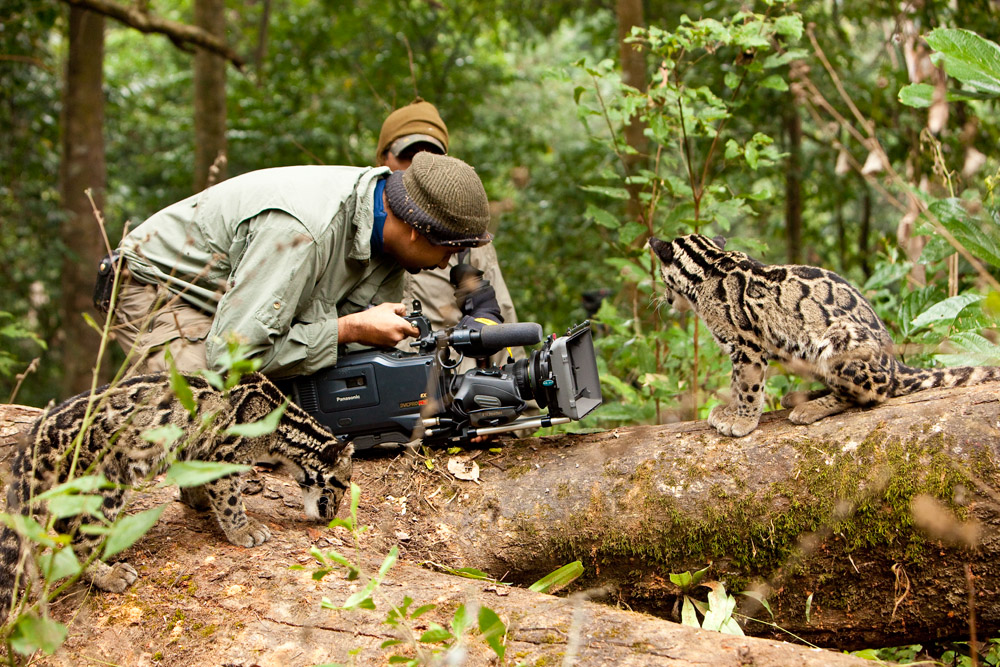
I followed these cubs living with them everyday while the cubs explored their forest surroundings. It’s amazing how quickly their cat instincts kicked in and before long they were making their own kill of junglefowl and squirrel.
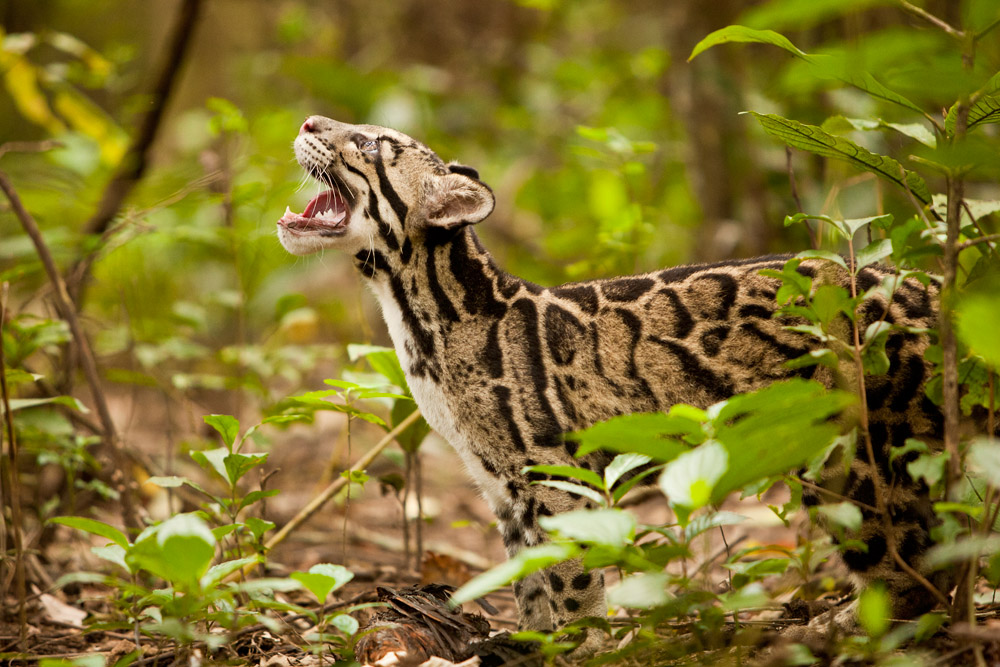
Clouded leopards earn their name from the big blotches of cloud-like markings on their coat, another reason why they are hunted. Their pelt is used to adorn sheaths, hats and other human ornaments.

These cats are made for a life living in trees. They can sprint straight up a vertical tree trunk with no problem, as if running on flat ground. Their rear ankles are modified much like squirrels, so they can actually come down the trunk of a tree headfirst!
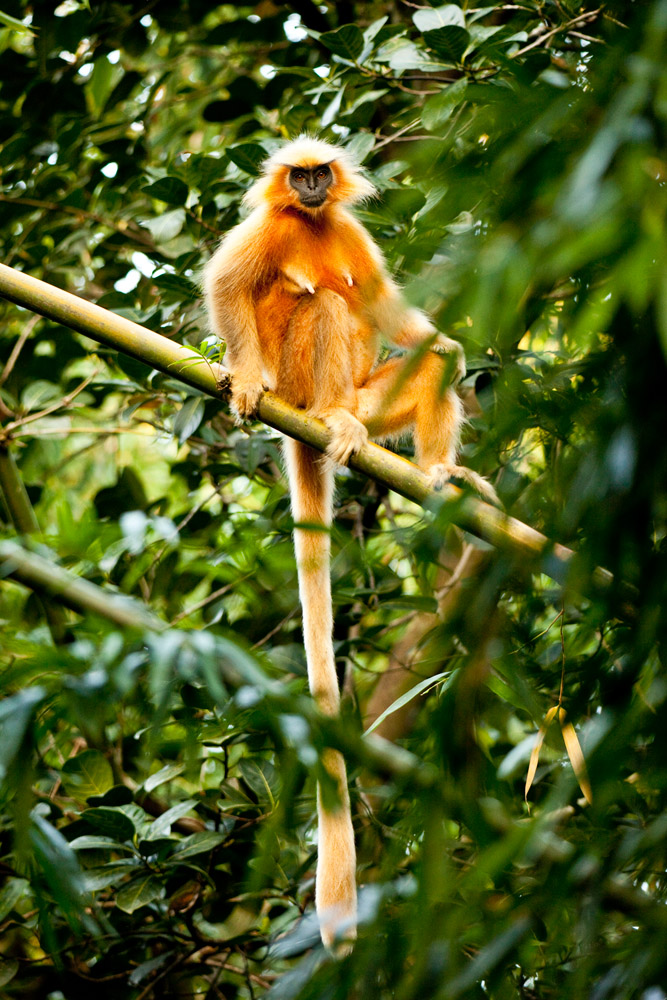
Other arboreal species like golden langurs form part of the prey base of clouded leopards. For now all Runaa and Khota could do was to chase these langurs from tree to tree.

Clouded leopards can open their jaw wider than any other big cat and in relation to their skull size possess the largest canines among the Big Cat family. At 5 centimeters (2 inches) in length a full-grown clouded leopard’s canines are nearly the same size as a tigers’!
After nearly two years we completed the documentary about Runaa and Khota. If you’d like to learn more about cloudys or how Runaa and Khotaa got along – watch Return of the Clouded Leopards on National Geographic! Here’s a short excerpt from the film which aired on National Geographic’s Big Cat week in December of 2011.
You can buy a copy of the DVD here, or wait and watch it on National Geographic WILD. I don’t have word of the air date in India, but keep an eye on this space for more details.
Tentative air details: Asia 21st Feb 2012 2000 Hrs Australia 19th Feb 1930 Hrs
This documentary is dedicated to wildlife Vets like Panjit Basumatary and Bhaskar Choudhury. They are the animal doctors and dedicate their lives to helping animals like Runaa and Khota – no easy task.
 I was fifteen years old or so when my father brought a set of VHS cassettes home to watch. For the present day audience a VHS – short for Video Home System, nurse was a tape format akin to what optical DVD’s are now and the dominant form of home entertainment at a time when television programs were scarce and broadcast networks like Discovery, National Geographic, etc. non-existent in India. The cover of the VHS set had the image of a Killer Whale breaching near the shore with a dozen nervous seals in the foreground – a striking image. This was the ‘Trials of Life’ – a twelve-part BBC Natural History series about animal behaviour written and presented by ‘David Attenborough’. I remember watching the series over and over again glued to the fascinating world of animals and to the simple yet riveting presentation of natural history by a tall white man with large teeth and a lovely British accent.
I was fifteen years old or so when my father brought a set of VHS cassettes home to watch. For the present day audience a VHS – short for Video Home System, nurse was a tape format akin to what optical DVD’s are now and the dominant form of home entertainment at a time when television programs were scarce and broadcast networks like Discovery, National Geographic, etc. non-existent in India. The cover of the VHS set had the image of a Killer Whale breaching near the shore with a dozen nervous seals in the foreground – a striking image. This was the ‘Trials of Life’ – a twelve-part BBC Natural History series about animal behaviour written and presented by ‘David Attenborough’. I remember watching the series over and over again glued to the fascinating world of animals and to the simple yet riveting presentation of natural history by a tall white man with large teeth and a lovely British accent.
Fast-forward to 1999 – Jackson Hole Wildlife Film Festival. I was just beginning to take my first steps into documentary filmmaking. I attended the Festival and to my surprise present in the gathering was Sir David Attenborough. He had just completed another of the ‘Life’ series titled, ‘The Life of Birds’. At that time I earned part of my living leading bird tours in the neo-tropics and the Life of Birds was a bible. I remember meeting Sir David in the central lobby of the Grand Teton Lodge. It was an evening of wine and cheese and at the first opportunity we met, spoke and he jovially signed my shirt. The next day we met again and this time I got my book The Life of Birds autographed.
In all this my far-fetched dream was always to have something that I shot narrated by his voice. That dream came very close (2007) when the purple frog – Nasikabatrachus sahyadrensis was to be included in the BBC Series Life in Cold Blood. But due to many broadcast and production reasons it did not happen and the sequence was retained for Mountains of the Monsoon. Although the purple frog sequence would’ve been a very small part of a big series, to me, that itself would’ve been a dream fulfilled. Sir David was 81 years old and I figured that after this big series he would hang up his hat and retire and I lost all hope of having anything associated with the voice of a legend.
This image was shot by late Barry Paine – another great voice and mentor whose warm conversations and company I’ll miss at Festivals he so devoutedly attended.
In 2008 I met Sir David at Wildscreen. I was helping Tom Veltre, head of The Really Interesting Picture Company (holds the record for the production company with the longest name I think) with his film about George Schaller titled, ‘Nature’s Greatest Defender’. In it was a key interview with Attenborough and this was the first time wherein I interacted with him at a personal level. I presented him with a copy of my book – Sahyadris: India’s Western Ghats. As he flipped through the book, he paused on the page of the Fairy Bluebird and exclaimed, “ Ahh, Irena puella, one of my favourite birds…” and then continued looking through the book. His knowledge even of a place that he had hardly, if ever, traveled to was nothing short of remarkable!
Last year between January and June I worked along with Chinmay Rane on two film projects for National Geographic. One about Clouded Leopards for Cicada/NG and another titled, ‘Secrets of Wild India’ for Icon Films and National Geographic. This was to be a coffee-table book type documentary series about India’s natural history. My focus was on the first of the 3-part series covering the northeast Indian landscape along the foothills of the Himalaya and the Brahmaputra River. Kaziranga – a place I now call home was base camp and the wild inhabitants of the floodplain – rhinoceros, buffalo and elephant took center-stage in the film. While filming certain key sequences we often read out lines from the script, usually in a very Attenboroughesque manner, “In a remote clearing, a 30-year-old female Indian Elephant, heavy with milk, guards her newborn calf. Only hours old, she was born under the cover of darkness in the shelter of the forest. The other females of the herd gather to witness her first tentative steps…” Months later when I heard that, Sir David Attenborough, the voice behind the epics we so love, was to do the narration for ‘Secrets of Wild India’ I was silently overjoyed. Finally a dream realized…
Home to over a billion people, India is best known as a diverse mass of noise, crowds, colour and religious devotion. And she also has a wild side, populated by giants, predators and exotic creatures.
Narrated by the legendary Sir David Attenborough Wild India airs Mondays at 8pm to give you a fascinating insight into this world-within-a-world, as each show explores the country’s extraordinary landscapes and their inhabitants.
As for now the tentative Air dates and schedule is detailed below. Please check in to your local NG Wild TV schedule for more accurate timings.
It airs today in the UK and in Latin America – 6th Feb 8PM. I do hope you enjoy watching the show as much as we’ve enjoyed capturing it. Look forward to hearing your comments and please share this with your friends and family.
In India as in many parts of South Asia, disorder this is the time of the New Year. This is the time when the northward transition of the Sun from Dhanu rashi (Sagittarius) to Makara rashi (Capricorn) takes place. Known as Makara Sankranti – the harvest festival – it is a time that marks the ending of winter and the beginning of spring. A very auspicious time in the Hindu calendar as it is the beginning of a New Year. With this, I’d like to take the opportunity to launch my new website and blog wherein one can find answers to many questions and get a peep into the behind the scenes of Wildlife filmmaking and photography. The website is still under-construction so check back frequently for more updates and features. The first photo-essay on the blog page is about my work with clouded leopards for an upcoming documentary.
———————————————————————————————————————————————————————————
In 2009 a dream project shifted my base camp to North-Eastern India. My job was simple albeit a bit broad – document the natural and cultural treasures of the Eastern Himalaya. One of my target species of course, was the clouded leopard. I knew my chances of seeing one was practically non-existent, but just knowing that somewhere in the jungles around me this cat prowls was enough to keep me excited and look for signs of its possible presence. I traveled all along the foothill forests of the Himalaya and although local people knew of the clouded leopard, finding one was nearly impossible.

Found through much of the forested regions of Southeast Asia, clouded leopards range from sea level up to about 2000 meters plus in the Himalaya.

With increased pressure on land clouded leopards numbers are declining. They are listed as Vulnerable in the IUCN Redlist with an estimated population of less than ten thousand individuals – a guesstimate at best.
The few animals that persist in human dominated landscape don’t survive for long. In most parts of Arunachal Pradesh and Nagaland men carry rifles as part of their everyday attire. They shoot whatever they come across that is sizeable enough to be eaten including clouded leopards.

My first sign of the presence of these cats came at a market place in Along. Here a clouded leopard skull adorned the sword, or Dhaow worn by the local headman’s son.

A few weeks later I stopped at a government run Handicraft shop in Pasighat – the headquarters of East Siang District in Arunachal. I was shocked to find a colourful stone, studded clouded leopard lower jaw adorning a Dhaow being sold for about 3000 Rupees – about 60 US dollars.

Skins and skulls of various rarely seen species are part of common adornment in the kitchens’ of many Naga tribes – the best place to do a faunal biodiversity inventory. In fact a new species of leaf deer unknown to India, or to science was found rummaging through these dusty collections of old skulls and bones.

A full-grown Clouded Leopard coat hangs inside a Naga kitchen. It was shot during the obligatory ‘no-hunting season’ by the village headman of Zipu village near Shatuza on the Indo-Myanmar border.
All in all, this was the closest I got to seeing a clouded leopard – a smelly skin of a clouded leopard shot just because it happened to be walking on the trail while the headman was on his way to work on his field.

Running parallel to the sad story of the plight of clouded leopards in the wild was the more uplifting story of Runaa and Khota, two clouded leopard kittens found along the Indo-bhutan border west of Manas Tiger reserve. Photo credit: Panjit Basumatary/ WTI
Panjit the vet at Wildlife Trust of India’s center for wildlife rescue in Kokrajhar was assigned the duty of looking after these cubs hardly a few days old. The cubs were confiscated by Sonali Ghosh who was the DFO in charge of the area and wanted to figure out a way to get the cubs back into the wild.


I heard about this six to seven months later and thought that it would make a wonderful story as it was the closest I was getting to seeing a clouded leopard in the wild. So I rushed to the area and began documenting the process of rehabilitation. Initially the cubs were led on a long leash to get them used to their new home – the forested foothills of the Bhutan Himalaya.

I followed these cubs living with them everyday while the cubs explored their forest surroundings. It’s amazing how quickly their cat instincts kick in and before long they were making their own kill of junglefowl and squirrel.

Clouded leopards earn their name from the big blotches of cloud-like markings on their coat, another reason why they are hunted. Their pelt is used to adorn sheaths, hats and other human ornaments.

These cats are made for a life living in trees. They can sprint straight up a vertical tree trunk with no problem, as if running on flat ground. Their rear ankles are modified much like squirrels, so they can actually come down the trunk of a tree headfirst!

Other arboreal species like Golden langurs form part of the prey base of clouded leopards. For now all Runaa and Khota could do was to chase these langurs from tree to tree.

Clouded leopards can open their jaw wider than any other big cat and in relation to their skull size possess the largest canines among the Big Cat family. At 5 centimeters (2 inches) in length a full-grown clouded leopard’s canines are nearly the same size as a tigers’!
After nearly two years we completed the documentary about Runaa and Khota. If you’d like to learn more about cloudys or how Runaa and Khotaa got along – watch Return of the Clouded Leopards on National Geographic! Here’s a short excerpt from the film which aired on National Geographic’s Big Cat week in December of 2011.
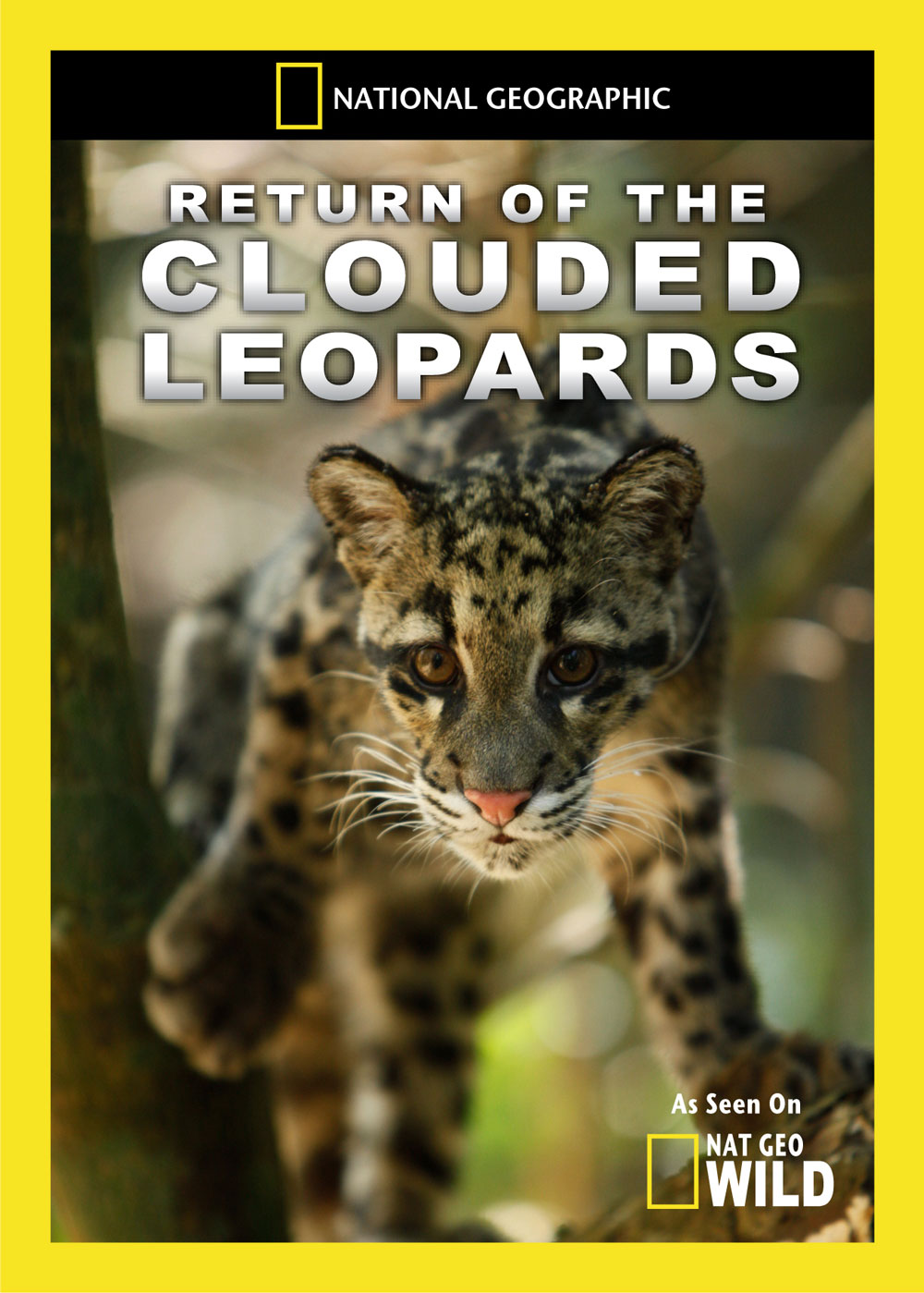 You can buy a copy of the DVD here, or wait and watch it on National Geographic WILD. I don’t have word of the air date in India, but keep an eye on this space for more details.
You can buy a copy of the DVD here, or wait and watch it on National Geographic WILD. I don’t have word of the air date in India, but keep an eye on this space for more details.
This documentary is dedicated to wildlife Vets like Panjit Basumatary and Bhaskar Choudhury. They are the animal doctors and dedicate their lives to helping animals like Runaa and Khota – no easy task.
Considered to be the largest moth in the world, cost the Atlas – Archaeoattacus edwardsii has a wingspan of nearly 25 Cm, cost 10 inches! Only the white witch moth (Thysania agrippina or Giant aggrippina) is larger: fully stretched, bronchi its wingspan can be as wide as 12 inches (30.5 cm). But the Atlas moth still wins over with a much broader surface area.
This image of the Atlas moth has made it’s way across various media around the world from Nicaragua to Nagaland. A viral image of sorts! I figured I may as well post it on my website and lay claim to the image!
The Atlas moth was photographed on the road in some part of remote Arunachal Pradesh. At first I thought the moth may be dead, but upon getting close to it, it raised it’s wings and spread them out. The colours and symmetry drew me into the image. At first I thought of shooting with a macro lens, but later decided that it would look much more striking with my Sigma 15mm Fish-eye. So most of these images were made at a distance of 4-5 cms from the moth revealing it’s character in close up. I need to dig out some more images of the moth with a person’s face in the background. You’ll see how the wingspan of the moth makes the face look small in comparison.
Camera: Canon 5DMark2
Lens: Sigma 15mm f/2.8 fish-eye
Flash: Canon 550 EX – Off camera flash with Diffuser


















July 30, 2012, 4:04 pm
sir, AADAB Isme Koi shak nahi ki aap kamal ke writer hai aur nayab hai, isyilie aap se yeh kehna ki bahut accha likhte hai kuch aisa hoga jaise ki main gulab se kahun ki bahut acchi mahak dete ho.vaise main chota sa writer hoon jo ki in dino apna aashiyan a niv rakhne ki koshish kar raha hai.yeh dekhkar accha laga ki aapne jo Faiz ki shayari aur filmi geeto ke connection ko aam insaan se rubru karaya.vaise maine yeh bhi note kiya hai ki shayri se geet to banate hai par yanha to geeto se bhi geet ban rahe haijaise aapne suna hoga Popular song : JANE KYU LOG MOHABBAT KIYA KARTE HAI, DIL KE BADLE DARDE DIL LIYA KARTE HAI Phir Dil Chata Hi ka Jane Kyun log pyar karte hai. Jane kyu wo kisi pe marte hai Khair yeh sab chalta rahta hai, Vaise 1 baar kahna chahunga ki GUSTAKHI MAAF jo itna kuch comments main likha agar kuch galti ho to maaf kijiyega, Khuda Hafiz aur khuda se yahi chahunga ki aap yun hi hamesha sitare ki tarah falak main chamkate rahe, aur desh ke dusre writer jo hard work kar rahe hai aur jinhone shayari ko ibadat ki tarah liya hai zindgi main unhe safalta mile.your well wisher VIRENDRA SINGH (Lyricist)